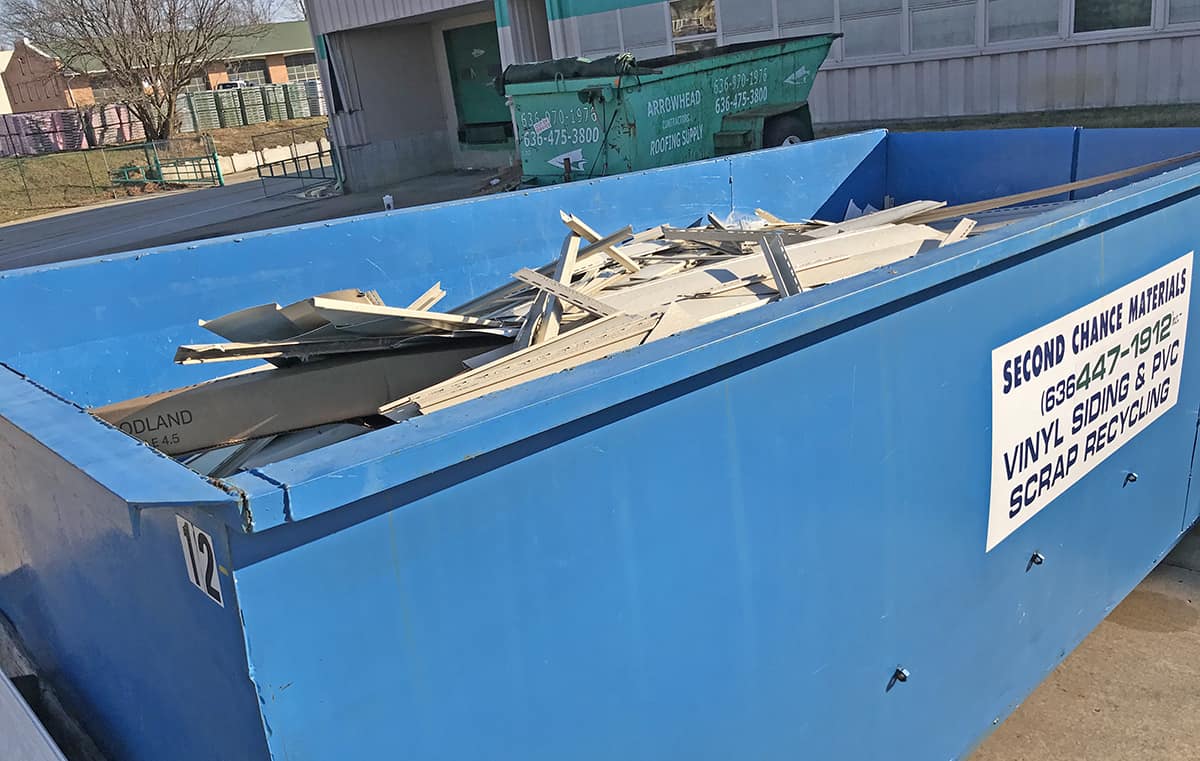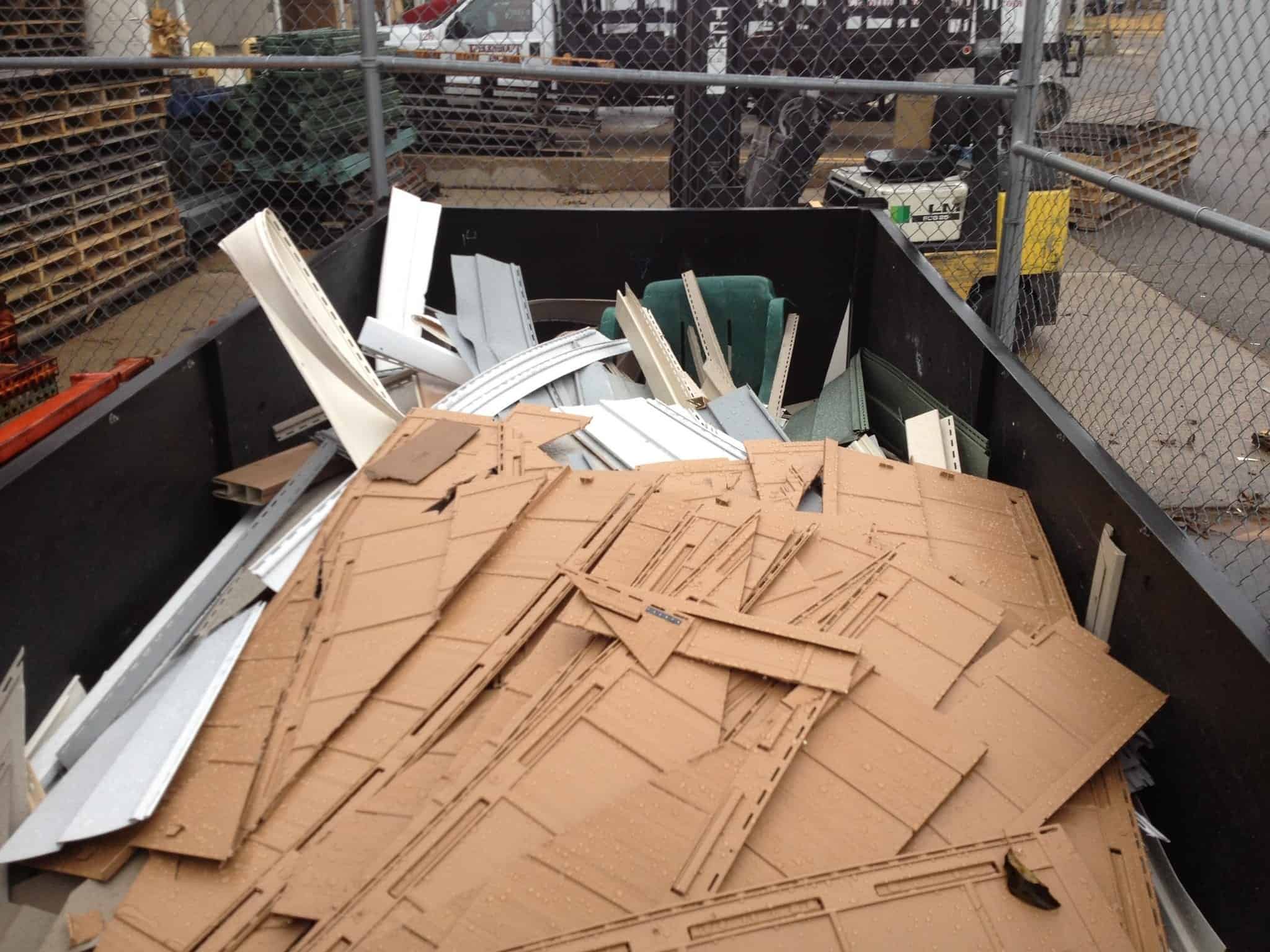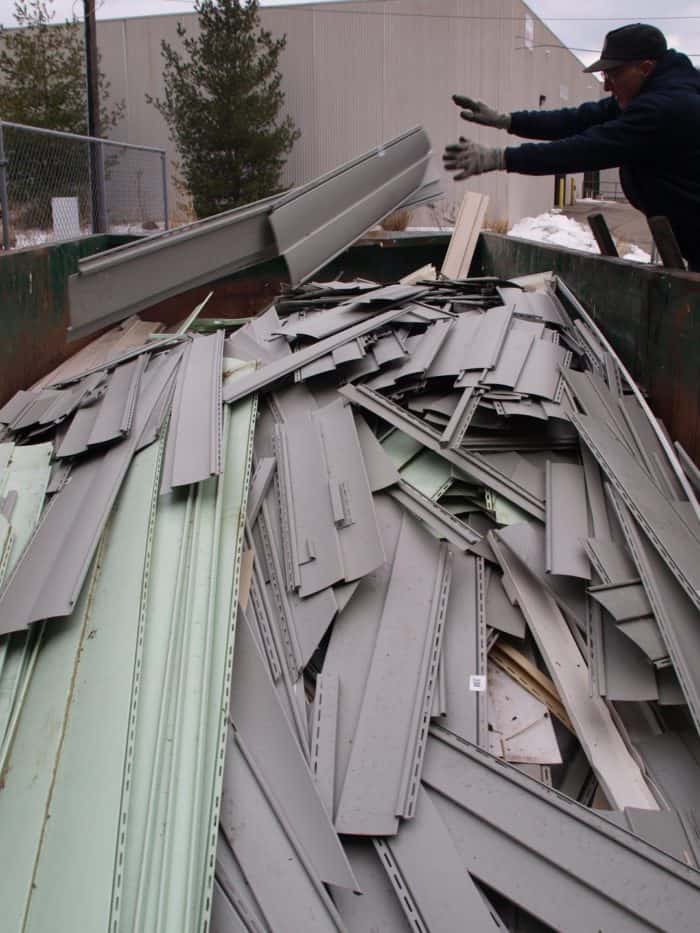Can you recycle vinyl siding? Yes, you can!
There is a solution for your vinyl siding recycling.
I will inform you how to dispose of vinyl siding properly while maintaining environmental awareness.
Table of Contents
Vinyl Around the World

The vinyl siding on your home is either made from virgin or recycled polyvinyl chloride (PVC). The accidental discovery of PVC in 1872 has metamorphosed into a widely used material with various applications.
PVC is a widely sought-after material in our world’s busiest industries, including construction, healthcare, automotive, electronics, sport, and fashion.
For you, PVC presents its versatile and durable characteristics as your home or business’s exterior cladding. In addition to impact strength, the weatherproofing capability that vinyl siding has can protect your home for between 20 and 40 years.
Nonetheless, you have decided to repair or replace the siding on your home or business. And so you are left with a pile of vinyl and have no idea how to dispose of it properly.
A Quick Note on Landfills
Landfills traditionally bear a negative connotation, and while I am not advocating for or against them, I was surprised to learn more about their uses and regulation.
I was pretty naive on the subject. In all honesty, I thought that a landfill was simply an undisclosed location allowing highly irresponsible dumping of unwanted materials. But, boy, was I wrong!
Did you know that a landfill is the least preferred method of waste management according to the United States Environmental Protection Agency’s waste management hierarchy?
Landfills must adhere strictly to the guidelines set forth under The Resource Conservation and Recovery Act (RCRA), aiming to ensure environmentally responsible practices for waste management.
We will retouch this subject later in the article as we discuss how to recycle vinyl building products.
What is PVC?
Let us talk a little more about PVC before we address your options for recycling your vinyl siding. Firstly, it has been in production since 1933. According to the British Plastics Federation, PVC “accounts for about 20% of all plastic manufactured worldwide, second only to polyethylene.”
The raw materials used in the production of polyvinyl chloride include salt and oil. Before PVC’s commercial use, it mixes with various special additives depending on its finished purpose.
This process, widely referred to as compounding, establishes the mechanical properties of your vinyl siding. Namely, vinyl siding is recognizable as durable, versatile, lightweight, and weatherproof.
More specifically, vinyl siding contains lubricants, stabilizers, and plasticizers. In addition, manufacturers may add fire retardants and colorants during production.
If you are interested in the data and safety sheets regarding PVC, please visit ChemicalSafetyFacts.org. Even though PVC is entirely recyclable, you should know that it is a Number 3 Plastic.
The Plastics Industry Association has identified plastics into seven groups based on their recyclability. Unfortunately, PVC falls into group 3, a “poison plastic because it contains numerous toxins and is harmful to our health and the environment.”
A Pile of Vinyl Siding

Has your home’s facelift project left you with a big pile of vinyl siding, and you don’t know what to do? It is entirely understandable, and no reason to feel ashamed badly.
Vinyl siding is a durable thermoplastic, which means that it “is designed for recycle-ability.” While it may be true that PVC products are not privy to conventional recycling efforts, there is still hope.
The truth is, companies all around the world are continually redesigning their manufacturing processes to encourage sustainability. People do not want to buy from an entity that turns their back on the environment.
Even if you are not a die-hard Go-Green advocate, with the range of competition that exists for practically any product imaginable, I’m sure that you will also feel better if your purchase respects our mother Earth.
Recycle-Ability
Remember that term thermoplastic that we discussed earlier? Because of this, vinyl products can be ground and reformed. What is critical to remember here is that the recycling of PVC is of great economic and environmental benefit.
Because of PVC’s ability to be reformed, 99% of all vinyl manufactured is usable. In addition, “about 18 million pounds of post-consumer vinyl are also recycled annually.”
The British Plastics Federation further notes that PVC leaves a smaller carbon footprint than lamb, aluminum, and cheese.
Who Wants Your Vinyl Siding?

The Vinyl Institute offers cradle-to-the-grave advocacy for continuous improvement in the vinyl industry. In addition, initiatives similar to their Sustainability Council exist internationally, reaching out to all stakeholders.
You can effortlessly search for local recycling plants and other organizations that will happily recycle your vinyl siding. However, various options exist, such as Scrapo, the world’s largest plastic recycling marketplace.
In some cases, if you have your project professionally installed, the installer may haul away your old vinyl siding for a small fee. However, remember that this latter possibility does not guarantee that the vinyl will make it to a recycling facility.
The onus is on you to ensure that your old vinyl siding arrives at a suitable recycling center. You can search this Recycling Directory as your first option.
How is it Recycled?
The two fundamental methods used to recycle PVC include mechanical and feedstock recycling. The first does not alter the molecular chain, whereas the latter does.
In addition, mechanical recycling requires rigorous sorting methods, which start with us as consumers. Feedstock recycling processes can handle multiple waste streams to include unsorted plastic composites.
Mechanical Recycling
During mechanical recycling, a physical process takes place to reform the plastic waste; however, there is no change to the stock polymer.
The plastic waste will be reformed by “cutting, shredding or washing into granulates, flakes or pellets of appropriate quality for manufacturing, and then melted to make the new product by extrusion.”
The shredding process is also known as a subcategory of mechanical recycling using conventional technology. However, there also exist non-conventional technologies which use solvent-based processes for PVC extraction.
Using mechanical engineering, PVC can be reformed several times without causing any deficiency to its original structure.
Feedstock Recycling
This recycling method requires a chemical process to revert the plastic waste into its original components. Pyrolysis, hydrolysis, and heating are the main techniques used.
The resulting products are then used for the production of new PVC, to feed other chemical manufacturing processes, or as fuel for energy recovery.
PlasticsEurope explains that Energy Recovery is yet another good alternative for plastic waste that, for some reason, “cannot be recycled in an eco-efficient manner.”
Biodegradable vs. Non-biodegradable
Reality Check! Vinyl siding is a non-biodegradable product meaning that it can not break down by natural means. Therefore, improperly disposed of vinyl siding negatively impacts both land and marine life.
Even if vinyl siding were biodegradable, the situation would not be a significant improvement. This is because there are very distinct differences between biodegradable, non-biodegradable, and compostable products.
Compostable products break down naturally in the environment, leaving no toxic residues behind. Biodegradable products break down in the natural environment, usually within a specified period. Nonetheless, biodegradable products may still release toxins into the atmosphere or leave small physical traces behind.
Non-biodegradable plastic in our waterways can harm birds, fish, and other marine life. On land, people and animals stand to be affected likewise.
The Alternative
I discovered and found it worth mentioning that “developments in bio-based PVC formulations or even to produce bio-based PVC resins are gaining momentum in recent years.”
Bio-attributed PVC offers both rigid and flexible applications and maintains the same performance criteria as traditionally produced PVC. As a result, innovation giants such as VYNOVA work continuously to reduce carbon dioxide emissions by more than ninety percent compared to conventional PVC.
Recycling Checklist
Below is a quick reference guide that you can follow that outlines some essential tips to remember from the onset of your vinyl siding removal through to its recycling.
- Remove any clutter from the proximity of your home. Set your working area up for success.
- Rent a dumpster or designate a safe place on your property to pile up the old vinyl siding.
- Use a vinyl siding removal tool to separate your vinyl siding planks carefully.
- Exercising caution, make sure to separate foam, rubber, nails, or other products from your vinyl siding.
- Locate and contact a vinyl siding recycling center in your area.
- Arrange for transportation of your used vinyl siding to a specified PVC recycler nearest you.
I cannot stress enough the importance of taking responsibility for ensuring that your vinyl siding reaches a suitable PVC recycler.
Do your part
I understand that the exterior curb appeal of your home can significantly increase its market value. However, in with the new necessitates an out with the old.
So I sincerely hope that this article has opened your eyes to the many recycling options available for plastic, specifically your vinyl siding.
I challenge you to Do Your Part to ensure that your vinyl siding does not end up at the landfill. It simply does not have to!
Please feel free to comment below with any questions or concerns on recycling your vinyl siding.